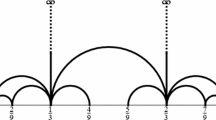Abstract
A multidimensional continued fraction algorithm is a generalization of the ordinary continued fraction algorithm which approximates a vector η=(y 1,...,y n ) by a sequence of vectors\(\left( {\frac{{a_{j,1} }}{{a_{j,n + 1} }}, \ldots ,\frac{{a_{j,n} }}{{a_{j,n + 1} }}} \right)\). If 1,y 1,...,y n are linearly independent over the rationals, then we say that the expansion of η isstrongly convergent if
This means that the algorithm converges at an asymptotically faster rate than would be guaranteed just by picking a denominator at random.
The ordinary continued fraction algorithm can be defined using the Farey sequence, approximating a number by the endpoints of intervals which contain it. Analogously, we can define a Farey netF n, m to be a triangulation of the set of all vectors\(\left( {\frac{{a_1 }}{{a_{n + 1} }}, \ldots ,\frac{{a_n }}{{a_{n + 1} }}} \right)\) witha n+1 ≤m into simplices of determinant ±1, and use this algorithm to define a multidimensional continued fraction for η in which the approximations are the vertices of the simplices containing η in a sequence of Farey nets. The concept of a Farey net was proposed by A. Hurwitz, and R. Mönkemeyer developed a specific continued fraction algorithm based on it.
We show that Mönkemeyer's algorithm discovers dependencies among the coordinates of η in two dimensions, but that no continued fraction algorithm based on Farey nets can discover dependencies in three or more dimensions, and none can be strongly convergent, even in two dimensions. Thus there are no good multidimensional algorithms based on Farey nets.
Similar content being viewed by others
References
Brentjes, A. J.: Multi-dimensional continued fraction algorithms. Mathematical Centre Tracts 145. Amsterdam: Math. Centrum. 1981.
Brun, V.: En generalisation av kjedebrøken I. Skr. Vidensk Selsk Kristiania.6. Mat. Nat. (1919).
Brun, V.: En generalisation av kjedebrøken II. Skr. Vidensk Selsk Kristiania6, Mat. Nat. (1920).
Ferguson, H. R. P., Forcade, R. W.: Generalization of the Euclidean algorithm to all dimensions higher than two. Bull. Amer. Math. Soc.1, 912–914 (1979).
Hurwitz, A.: Über die angenäherte Darstellung der Zahlen durch rationale Brüche. Math. Ann.44, 417–436 (1894).
Lagarias, J. C.: Geodesic Multidimensional Continued Fractions. Preprint.
Mönkemeyer, R.: Über Fareynetze inn Dimensionen, Math. Nachr.11, 321–344 (1953).
Mönkemeyer, R.: Über die Strukturn-dimensionaler Fareynetze, J. Reine. Angew. Math.212 169–173 (1963).
Perron, O.: Grundlagen für eine Theorie des Jacobischen Kettenalgorithmus. Math. Ann.64, 1–76 (1907).
Schmidt, A. L.: Farey triangles and Farey quadrangles in the complex plane. Math. Scand.21, 241–295 (1967).
Szekeres, G.: Multidimensional continued fractions. Ann. Univ. Sci. Budap. Rolando Eötvös sect. math.13, 113–140 (1970).
Author information
Authors and Affiliations
Additional information
Supported by an NSF Graduate Fellowship.
Rights and permissions
About this article
Cite this article
Grabiner, D.J. Farey nets and multidimensional continued fractions. Monatshefte für Mathematik 114, 35–61 (1992). https://doi.org/10.1007/BF01572079
Received:
Issue Date:
DOI: https://doi.org/10.1007/BF01572079




